Dropsy (hydrocephalus) of the brain is called a pathology associated with a violation of the outflow of cerebral fluid. External hydrocephalus replacement develops mainly in adults. It is a type of disease in which excess fluid accumulates in the cerebral cortex, replacing its partially destroyed tissue.
Record content:
- 1 Features of the disease
- 2 Causes and mechanism of development
- 3 Classification
- 4 Symptoms
- 5 Diagnostics
- 6 What is dangerous
- 7 Drug treatment
-
8 Surgical intervention
- 8.1 Bypass surgery
- 9 Folk remedies
- 10 Rehabilitation and prognosis
- 11 Video about hydrocephalus
Features of the disease
Due to the fact that the symptoms of dropsy in children of the 1st year of life are more pronounced, it is accompanied by:
- well noticeable changes in the shape of the head;
- bulging fontanelle;
- developmental lag.
In medicine, for a long time, the prevailing opinion was that only babies were ill with hydrocephalus. In fact, people of all ages are susceptible to this disease, but its causes, symptoms and consequences in adults and children are different.
External replacement hydrocephalus in adults, depending on the etiology Diseases and places where excess fluid collects and the degree of brain damage can:
- proceed easily, making itself felt only by headaches;
- cause serious consequences, sometimes leading to profound disability or death;
- have a chronic, subacute or acute form, differing in symptoms and methods of treatment.
Causes and mechanism of development
The human brain, enclosed in the cranium, is located in the cerebrospinal fluid (livcor), which performs 4 essential functions:
- Protection of the brain from mechanical damage.
- Stabilization of intracranial pressure, compensation for its differences that occur when moving the head, talking, laughing - any actions performed by a person.
- Providing nutrition to brain cells.
- Removal of their waste products.
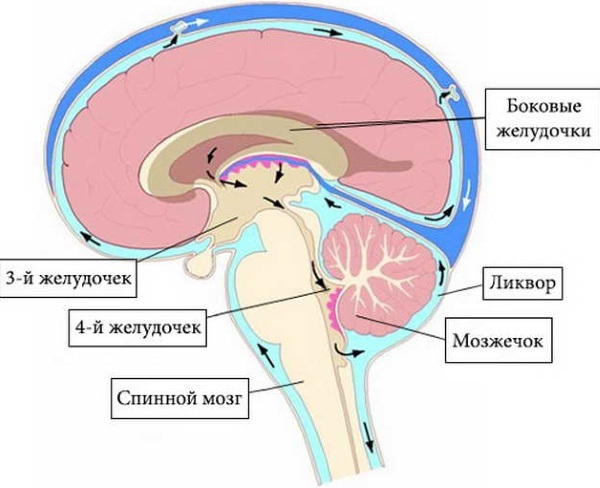
Normally, Livcore is produced in 4 ventricles of the brain, then through the interventricular canal and the cerebral duct it enters the space between the arachnoid and pia mater of the brain. It is removed by being absorbed through the capillaries that penetrate the arachnoid membrane into the venous blood.
The total amount of cerebral fluid remains unchanged; for an adult, its volume should be in the range from 140 to 270 ml.
If the process of circulation (outflow) of livcore is slowed down, and the ventricles continue to produce it in the same volume, then excess fluid will accumulate, creating unnecessary pressure on certain brain structures and causing disturbances in them work.
Hydrocephalus will develop, the main causes of which are:
- head trauma;
- age-related changes in the vessels of the brain;
- strokes, cerebral hemorrhage;
- neoplasms, brain tumor
- unfavorable heredity;
- hypertension;
- infections and inflammatory diseases affecting the brain, in particular meningitis and encephalitis;
- severe cardiovascular disease.
In some cases, the cause of the disease cannot be identified.
External replacement hydrocephalus in adults has its own characteristics in development. It is associated with the appearance of cavities in the membranes of the brain, which are the result of the destruction (atrophy) of their tissues. In the presence of voids, cerebral fluid from the subarchnoid space enters them, replacing the destroyed tissues. In this case, the volume of the brain decreases.
The causes of brain tissue atrophy can be:
- atherosclerosis and other diseases of the vascular system;
- encephalopathy (chronic nutritional deficiency of brain tissue);
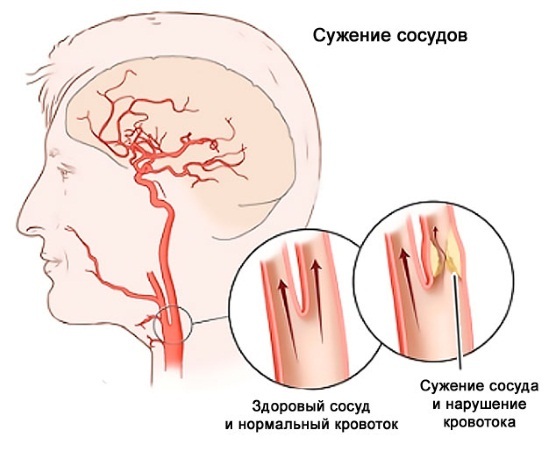
- regular poisoning of the body with alcohol, nicotine, drugs;
- traumatic brain injury (in the absence of adequate treatment);
- age-related diseases associated with degenerative brain changes: Alzheimer's, Parkinson's, Huntington's, Pick's;
- increased intracranial pressure;
- infectious diseases affecting the brain;
- exposure to radiation.
The following factors increase the risk of tissue atrophy and the development of atrophic hydrocephalus:
- frequent stress;
- insomnia;
- unhealthy diet;
- water imbalance due to dehydration or excessive fluid intake;
- work with potentially hazardous substances that can cause poisoning: heavy metals, poisonous gases, pesticides, paints, solvents.
In adults and children, there are 3 stages of development of atrophic (external replacement hydrocephalus):
| Stage | Description |
| Initial | Atrophy is insignificant, there are no symptoms, the patient feels well, there are no complaints or the person does not pay attention to them. This could be:
|
| Moderate | There are noticeable symptoms:
|
| Expressed | Her symptoms are as follows:
|
Classification
The classification of hydrocephalus is complex, since it takes into account several criteria at once.
By the time of occurrence, it can be:
- Congenital. It is formed in the womb under the influence of diseases suffered by her during pregnancy: toxoplasmosis, syphilis, cytomegaly.
- Acquired. Appears after birth under the influence of certain factors: infections, inflammation, trauma.
By localization of excess fluid, it can be:
- Internal. In this case, Livcore accumulates in the ventricles, which at the same time increase in size, squeezing nearby tissues. It can be caused by blockage of the channels connecting the ventricles with the space between the meninges.
- External. The accumulation of CSF is observed in the subarchnoid space: the membranes oversaturated with fluid expand and create excessive pressure on the brain from the outside. The cause of this hydrocephalus is usually a violation of the absorption capacity of the vessels of the brain.
-
Mixed. This case combines the inner and outer shapes.

According to the mechanism of development, it can be:
- Open, when the connection between the ventricles and the cavity between the meninges is maintained. The cause may be an increased secretion of cerebral fluid.
- Closed. With her, this connection is broken (blockage of outflow channels).
For reasons of appearance, the following types are distinguished:
- Post-traumatic, which appeared after a traumatic brain injury.
- Post-infectious, which is a consequence of the transferred neuroinfectious diseases.
- Post-hemorrhagic, developing as a result of a violation of the integrity of blood vessels and hemorrhage in the ventricles of the brain. It is mainly diagnosed in newborns.
- Tumor, in which the tumor can block the outflow of livcore or stimulate its production.
By the nature of the course and the rate of development, the following forms differ:
- Progressive (acute), in which no more than 3 days pass from the moment the first symptoms of the disease appear to the development of persistent disorders of the brain.
- Subacute, which takes a month to develop.
- Compensated (chronic), characterized by a slow but steady deterioration of the patient's condition within six months.
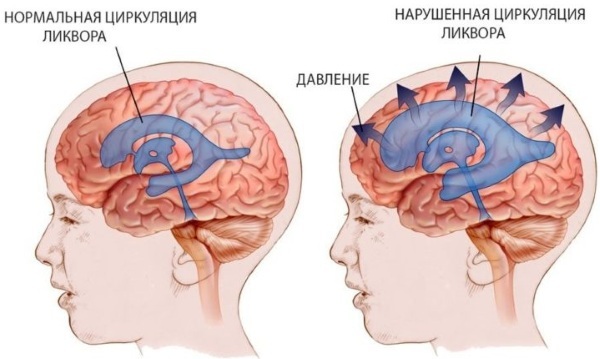
According to the effect on the indicators of intracranial pressure, it can be
- Hypertensive, leading to its increase.
- Normotensive, not changing pressure.
- Antihypertensive, reducing it.
External hydrocephalus replacement in adults is a type of external hydrocephalus in which excess fluid fills the damaged, atrophied areas of the brain. With this form of dropsy, an increase in intracranial pressure is not observed.
The disease can be congenital or acquired. As a rule, it is chronic and develops in old age. Its acute form is less common, as a result of head injuries and neuroinfections.
Symptoms
The symptoms of dropsy of the brain are largely dependent on age.
In children of the 1st year of life, they are brighter:
- an increase in the volume of the skull;
- thinning of the bone and divergence of the cranial sutures;
- the appearance of a well-visible venous pattern on the scalp;
- strabismus;
- developmental lag.
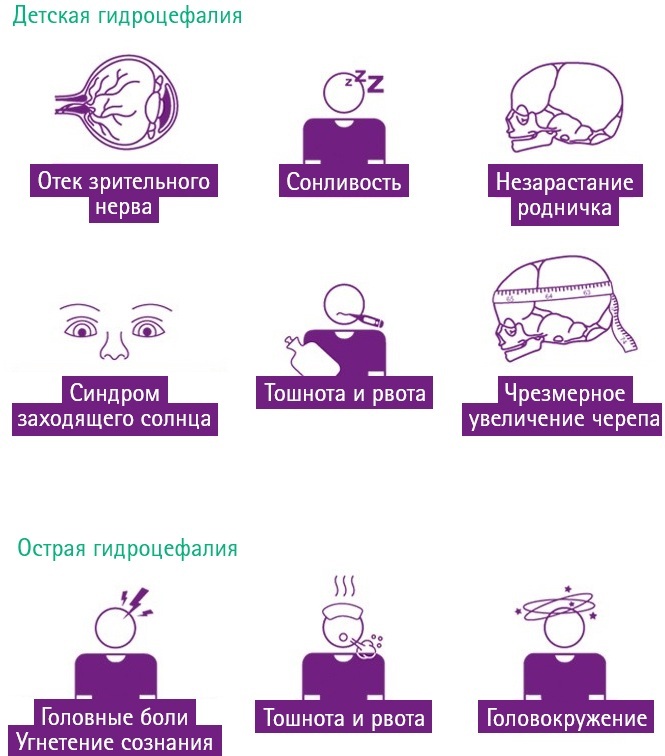
In adults, symptoms are less pronounced, many of them can be attributed to other diseases.
This is:
- frequent and severe headaches that do not disappear even after taking pain medications;
- disorders of the vestibular apparatus;
- nausea, vomiting;
- deterioration of vision: double vision, fogging, narrowing of the visual fields;
- decreased motor ability of the limbs, sometimes - complete paralysis;
- decrease in tactile abilities;
- the disappearance of the sensitivity of the skin.
With atrophic hydrocephalus, the disease is asymptomatic for a long time or its manifestations are so weak that they are mistaken for fatigue and overwork. Later, the symptoms intensify, become more pronounced, but are often mistakenly believed to be the result of various mental disorders, which leads to misdiagnosis and inappropriate treatment.
It can be:
- memory losses;
- decreased mental ability;
- difficulty in pronouncing words;
- gait disturbances;
- bed-wetting;
- irritability, aggressiveness, inappropriate behavior.
Diagnostics
Other types of dropsy, as well as diseases not associated with cerebral edema, can give similar symptoms with external replacement hydrocephalus.
The main goals of diagnostic studies are:
- Clarification of the diagnosis and detection of indisputable signs of atrophy of the medulla.
- Determination of the factor that led to changes in brain tissue: infections, head injuries, tumors, heredity, lifestyle.
- Choosing the optimal treatment method.
To solve these problems, the following procedures are performed: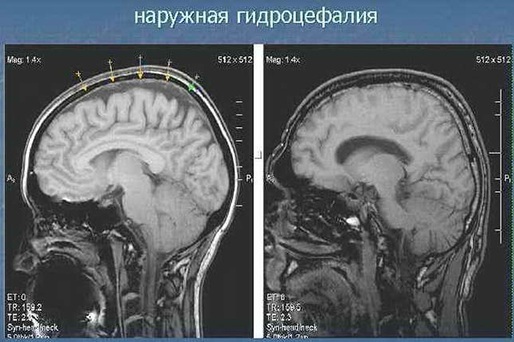
| Procedure | Description |
| MRI | The method consists in influencing the necessary parts of the brain with electromagnetic waves and obtaining a series of images that provide comprehensive information about the structure of the brain. Especially informative are studies done at different times, which allow you to see the dynamics of changes. |
| CT scan | Computed tomography is similar to MRI, but instead of electromagnetic waves, it uses X-rays. |
| Ultrasound | Ultrasound examinations will show if there are diseases that can cause brain tissue atrophy. |
| Doppler diagnostics | Investigation of the features of blood flow in the membranes of the brain and determination of violations of the process of absorption of cerebral fluid. |
| Lumbar puncture | It allows you to examine the cerebrospinal fluid. |
| Laboratory blood tests | They are necessary to determine its biochemical parameters: coagulability, cholesterol levels, and the presence of hormones. |
In addition, as part of the diagnosis, the patient may be asked to undergo additional examinations from a number of specialists:
- endocrinologist;
- ophthalmologist;
- Laura.
Their goal is to exclude other causes of the identified symptoms and determine if there are any contraindications to certain methods of treatment.
What is dangerous
The main danger of open replacement hydrocephalus is that it develops almost asymptomatically for a long time. When the symptoms begin to disturb the patient, and he goes to the doctor, the disease reaches intractable stages, and the volume of the brain due to atrophy of brain tissue is reduced so much that the changes become irreversible.
When the symptoms begin to disturb the patient, and he goes to the doctor, the disease reaches intractable stages, and the volume of the brain due to atrophy of brain tissue is reduced so much that the changes become irreversible.
Drug treatment
The goal of conservative treatment is to eliminate the cause of the disease and relieve symptoms.
At the initial and moderate stages, drugs are used to combat edema and stabilize the patient's condition:
- contributing to the removal of excess fluid from the body;
- antibiotics (for post-infectious hydrocephalus);
- normalizing blood supply to the brain;
- lowering the level of glutamate - a substance that contributes to the destruction of neurons;
- antioxidants that normalize the functioning of nerve cells.
The course of drug treatment is prescribed by a doctor. Most of the drugs used for hydrocephalus have many side effects, therefore, if used incorrectly, they can cause serious damage to health. Self-medication in this case is unacceptable.
In addition to drug therapy, the patient can be recommended as restorative measures:
- a set of exercise therapy exercises, developed by a specialist, taking into account the causes of the disease and the patient's condition;
- restriction in fluid intake;
- adherence to a diet;
- medicinal baths based on pine extract;
- electrotherapy;
- massages.
With timely initiation of treatment, patients experience:
- gradual relief of symptoms;
- strengthening the blood vessels of the brain;
- normalization of their ability to absorb liquid.
Surgical intervention
If conservative methods are ineffective, surgical treatment is used. In the arsenal of modern neurosurgery, there are several minimally invasive methods for normalizing the amount of cerebral fluid, which consists in creating an additional pathway for the outflow of livcore.
As a rule, endoscopic surgery is performed through the nasal passages, after which no open scars remain.
Bypass surgery
If endoscopic surgery is impossible or ineffective, a bypass method is used to normalize the outflow of cerebrospinal fluid. It consists in installing a shunt under the scalp - a thin hollow silicone tube equipped with a valve that prevents fluid backflow.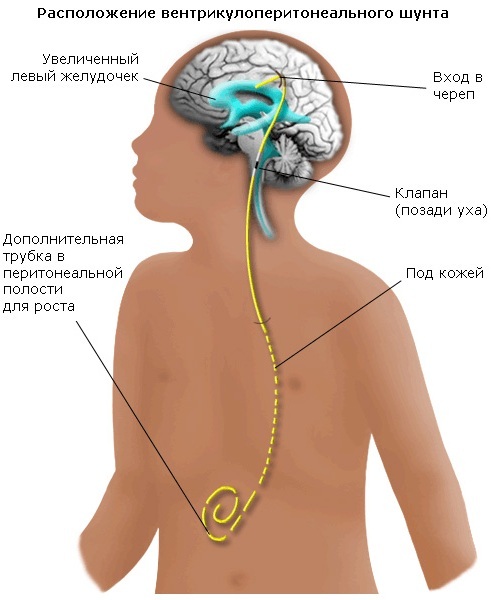
There are shunting:
- verticulo-peritoneal - when excess livcore is sent to the abdominal cavity;
- verticulo-atrial - the other end of the shunt is sewn into the circulatory system.
The most common indications for bypass surgery are types of hydrocephalus that develop as a result of a stroke or traumatic brain injury.
Treatment exclusively by bypass surgery is also possible in the presence of a concomitant pathology of dropsy, known as normal pressure hydrocephalus (NTG), which usually develops in elderly patients (older 65 years old).
The operation is performed after a thorough examination, which is prescribed by a neurosurgeon to confirm the diagnosis and select the optimal type of bypass surgery.
Contraindications to conduct may be:
- infectious and inflammatory diseases;
- skin infections;
- unsatisfactory condition of the oral cavity.
The limitations are due to the fact that the shunt, being a foreign body, can provoke an increase in inflammatory processes in the body.
The operation is performed under general anesthesia and lasts approximately 1 hour. To insert the shunt, the neurosurgeon makes incisions in the head and neck (abdomen) area. The duration of the postoperative period is no more than 5 days, during which the patient remains under the supervision of a doctor. Pain relievers are used to relieve pain in the incision area.
Depending on the severity of the disease and the characteristics of the patient's body, an improvement in his condition can be observed immediately after the operation or after a month. The shunt remains for life, periodically, due to wear and tear and the occurrence of various defects, it requires correction.
Folk remedies
Traditional medicine can only provide symptomatic treatment.
After consulting a specialist, some of her techniques can be applied:
- to alleviate the patient's condition;
- to improve the effectiveness of medications;
- as part of rehabilitation therapy in the postoperative period.
External replacement hydrocephalus in adults in treatment can be supplemented with the following folk recipes:
- Grind the garlic with radish in equal proportions into gruel, squeeze the resulting juice and take it for ½ tsp. l. 3 times a day for 3 weeks.
- Finely chop the root of the black elderberry, add alcohol (10 parts of alcohol for 1 part of the crushed root). Insist for 7 days, then take 25 drops three times a day.
- Dry and chop buckthorn bark or berries. Take the resulting powder (½ g, 3 times a day), use as a decoction (1 tbsp. l. 3 times a day). You can replace the powder with buckthorn extract purchased at the pharmacy, drinking 30 drops daily in 3 doses.
- Pumpkin juice will remove excess fluid from the body, cleanse the body, and normalize sleep. To prepare it, you need to pass the pumpkin pulp through a juicer. For treatment, only fresh juice is used, which can be stored no longer than 2 days, drink half a glass every day.

pumpkin juice - Infusion of birch buds and leaves: chop dry birch leaves or swollen buds, pour vodka (1: 1), leave for 3 weeks. Strain, drink, diluting ½ tsp. l. infusion in 1 tbsp. l. water, 3 p. in a day.
- Melissa is able to relieve migraine, accompanying hydrocephalus. 15 g of grass pour 1 tbsp. boiling water, leave for 2 weeks, drink 15 drops after each meal.
- Cornflower has the ability to remove fluid from the body and fight bacterial infection. To prepare the broth, pour 1 liter of boiling water with 50 g of dried color, take 50 g of the broth after meals.
Rehabilitation and prognosis
With medical and surgical treatment of hydrocephalus, the cause of the disease is eliminated and the circulation of cerebrospinal fluid is normalized. To restore the full functioning of the brain, motor activity, speech, vision and other functions lost in the course of the disease, a long rehabilitation period is required.
The patient may be offered:
- Physiotherapy. Exercises are prescribed by a doctor, performing them, you must strictly follow the recommendations of a specialist, without trying to force events, increasing the intensity or duration of the exercise. Neglect of this rule can worsen the patient's condition.
- Massage. It will strengthen muscles and tone them up.
- Classes with a speech therapist, neuropsychiatrist. This will allow you to quickly cope with the manifestations of aphasia and remove the irritability, aggressiveness, depression associated with these difficulties, accompanying this condition.
- A set of measures aimed at eliminating cognitive disorders: restoration of memory, ability to concentrate, ability to think logically.
There is no universal method of rehabilitation for patients with dropsy of the brain.
The choice of specific techniques depends on several factors:
- age;
- the degree of brain damage;
- the specifics of previous treatment;
- the presence of concomitant diseases.
Provided that external replacement hydrocephalus was detected at the early stages of development, competent treatment and fulfillment of rehabilitation requirements, the disease is completely curable, changes in the structure of gray matter reversible. As a rule, the patient, after the end of the recovery period, can lead a normal life.
At the 2nd and 3rd stages, it is possible to partially relieve the symptoms and alleviate the patient's condition, sometimes to stop the development of the disease, but it is no longer possible to reverse the process of brain destruction. A number of restrictions are imposed on a person, the purpose of which is to prevent a relapse and an increase in hydrocephalus symptoms.
If untreated, the disease progresses, the brain volume gradually decreases, which leads to:
- further decrease in intellectual abilities;
- the extinction of motor functions;
- loss of vision.
Ultimately, a person becomes a deeply disabled person, in some cases a lethal outcome is possible.
It is difficult to detect external hydrocephalus replacement in the early stages, its treatment takes a long time and does not give a 100% guarantee of recovery, and the consequences of the disease can be unpleasant.
However, you can try:
- avoid head injury;
- follow the vaccination schedule that will protect against neuroinfections;
- quit smoking and alcohol consumption;
- regularly undergo MRI examinations;
- at the first signs of illness, consult a doctor.
These simple steps will minimize the risk of an intimate exposure to external hydrocephalus replacement hydrocephalus in adults and keep your brain healthy.
Video about hydrocephalus
About cerebral hydrocephalus:



